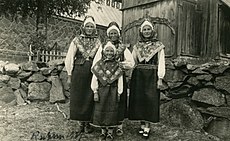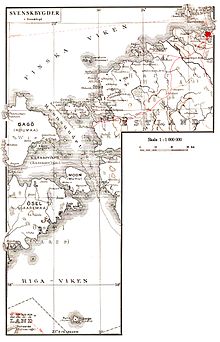Estonian Swedish
| Estonian Swedish | |
|---|---|
 Estonian Swedes on Ruhnu, 1937 | |
| Region | Estonia, Ukraine |
Native speakers | unknown |
Indo-European
| |
| Language codes | |
| ISO 639-3 | – |
| Glottolog | esto1259 |
| Part of a series on the |
| Swedish language |
|---|
| Topics |
| Advanced topics |
| Variants |
| Dialects |
|
| Teaching |
|
Higher category: Language |
Estonian Swedish (Swedish: estlandssvenska; Estonian: rannarootsi keel, lit. 'Coastal Swedish') are the eastern varieties of Swedish that were spoken in the formerly Swedish-populated areas of Estonia (locally known as Aiboland) on the islands of Ormsö (Vormsi), Ösel (Saaremaa), Dagö (Hiiumaa) and Runö (Ruhnu), and the peninsula (former island) of Nuckö (Noarootsi), by the local Estonian Swedes.[1]
Until the evacuation of the Estonian Swedes near the end of World War II, both Swedish and Estonian were commonly spoken on the named islands. It is not clear if there are any mother-tongue speakers left.[2] After Estonia's independence following the dissolution of the Soviet Union, Estonian Swedish experienced a revival, with courses in the language being offered on Dagö and Ösel.

Currently the number of native speakers is unknown but assumed to be low.[3]
Samples[]
Estonian Swedish comprises a number of sub-dialects, for example Nuckömål and Rågömål.
An example of the Nuckömål dialect from the Nordisk familjebok, compared with standard modern Swedish:[citation needed]
- Stick tälknin i stolpan o hälvtor stolpan topa kalkan, säte Halmen o Hälma färe kalkan o ker te Nuckö toka.
Standard Swedish:
- Stick täljkniven i stolpen och vält stolpen på kälken, sätt Hjälmen och Hjälma för kälken och kör till Nuckö.
The Gammalsvenska dialect of Swedish spoken in Ukraine is an archaic dialect of Estonian Swedish, having been brought to the village of Gammalsvenskby in the late 1700s by settlers from Dagö.[4]
Writing system[]
Noarootsi Swedish is written with the same letters as Standard Swedish with a few phonetic additions:[5]
long vowels are indicated with a subscribed macron: ⟨a̱, ä̱, å̱, e̱, i̱, o̱, u̱⟩ ; long consonants are doubled : ⟨bb, dd, ...⟩ ; the /d/ and / n/ rhotics are denoted with a dot below ⟨ḍ, ṇ⟩ ; the Voiced retroflex flap /ɽ/, called "thick L", is noted with a dot below ⟨ḷ⟩; the voiceless postalveolar fricative consonant /ʃ/ is noted with a dot below ⟨ṣ⟩.
See also[]
References[]
- ^ "Svenska ortnamn i Estland" [Swedish place names in Estonia]. sprakinstitutet.fi (in Swedish). Institute for the Languages of Finland. Retrieved 2019-11-15.
- ^ Hammarström, Harald; Forke, Robert; Haspelmath, Martin; Bank, Sebastian, eds. (2020). "Estonian Swedish". Glottolog 4.3.
- ^ Rosenkvist, Henrik (2018). "Estlandssvenskans språkstruktur" [The linguistic structure of Estonian Swedish] (PDF) (in Swedish). University of Gothenburg. Retrieved 18 Jun 2020.
- ^ "Gammölsvänsk". The Language Archive. Nijmegen, Netherlands: Max Planck Institute for Psycholinguistics. hdl:1839/00-0000-0000-0008-A981-0. Retrieved 2 March 2021.
- ^ Brunberg 2010
- Swedish dialects
- Languages of Estonia
- Germanic language stubs
- Sweden stubs
- Estonia stubs